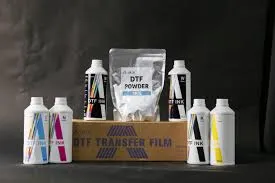DTF (Direct-to-Film) printing has quickly become a preferred method for printing on garments, thanks to its vibrant results, compatibility with various fabrics, and simple transfer process. But what truly sets professional-grade prints apart from average ones is the quality and selection of consumables: DTF ink, PET film, and hot melt powder.
Each of these components plays a crucial role in the final outcome of a print. When chosen and used correctly, they work together to produce stunning designs that are soft to the touch, durable, and visually striking. In this guide, we’ll break down how to choose the right consumables and use them effectively for best results.
To begin with, selecting high-quality DTF ink is non-negotiable. Your ink is the color engine of your design, responsible for both the vibrancy and durability of the final product. There are many options on the market, but if you’re looking for long-lasting, high-opacity colors that won’t crack or fade, it’s worth taking a look at the best DTF ink for sale from trusted manufacturers known for consistent print performance.
DTF Ink: The Foundation of Vibrancy and Detail:
DTF ink must be specially formulated to work with PET film and hot melt powder. It should flow smoothly through the printer, dry quickly, and maintain its color integrity under heat. Good ink provides:
- Rich Pigmentation: Ensures that colors are vivid and stand out on both light and dark fabrics.
- Stability: Helps prevent clogging in the printer and reduces downtime.
- Durability: Maintains brightness and flexibility even after multiple washes.
White ink plays a particularly important role as it forms the underbase for color prints, making colors pop on darker garments. If the white ink isn’t opaque or consistent, the entire design can appear washed out.
When comparing options, check reviews, test sample prints, and consider brands that specialize in DTF solutions. Avoid inks that settle too quickly or require excessive maintenance—those are signs of unstable formulations.
PET Film: The Unsung Hero of the Process.
The second key element in DTF printing is the PET film, which serves as the medium for transferring the ink to fabric. This film is specially coated to hold the ink and hot melt powder before pressing.
There are two main types:
- Hot Peel Film: Allows immediate removal after pressing.
- Cold Peel Film: Requires cooling before removal but often provides more consistent results for beginners.
Regardless of which you choose, good PET film should have:
- Even Coating: Helps ensure smooth ink absorption.
- Anti-Curling Properties: Prevents jams and misalignments during printing.
- Clarity and Clean Release: Ensures designs lift cleanly onto the fabric without smudging or residue.
Poor-quality film can cause patchy transfers or leave powder behind, ruining the finish. Stick with films tested and approved by experienced DTF users.
Hot Melt Powder: The Secret to Strong Adhesion.
Once the design is printed on PET film, hot melt powder is applied to bond the ink to the fabric during heat pressing. It acts like an invisible glue that creates a flexible yet durable layer between the fabric and the ink.
Key factors to consider:
- Powder Grain Size: Fine powder is best for detailed prints, while coarser grains may suit thicker fabrics.
- Adhesion Strength: Ensures that the print survives multiple washes without cracking or peeling.
- Soft Touch: The powder should melt evenly to create a smooth feel on the fabric.
- Color Options: Though white powder is standard, black or neutral-colored powders are sometimes used for dark fabrics to prevent visibility through the print.
Improper use of hot melt powder—such as applying too much or not curing at the right temperature—can cause stiff prints or poor wash durability. Always follow manufacturer guidelines for time and temperature settings.
Combining the Three: Why Quality Across the Board Matters:
Success in DTF printing comes from synergy. Even the best ink will underperform on poorly coated film, and the strongest adhesive powder can’t fix a faded design from low-quality ink. It’s essential to invest in all three consumables equally to ensure your prints are:
- Crisp and Detailed
- Bright and Eye-Catching
- Soft Yet Durable
- Wash-Resistant
For those serious about elevating their print game, finding a trusted supplier that offers consistency, reliability, and technical support is a must. That’s where experienced DTF solution providers like dtflinko.com come in. With a full range of carefully tested consumables, they make it easy to find the right combinations that work together harmoniously.
Tips for Effective Use of DTF Consumables:
Even with the best supplies, results depend on proper handling. Here are a few practical tips to get the most out of your materials:
- Keep Consumables in a Controlled Environment
Store inks, films, and powders in a dry, temperature-stable place to avoid clumping, warping, or degradation. - Use Precision When Applying Powder
Shake or sift the powder evenly over the print. Excess adhesive can lead to heavy, stiff prints, while too little may affect adhesion. - Monitor Printer Settings
Adjust your software settings for optimal ink laydown and white underbase strength based on fabric type and color. - Press with Accuracy
Maintain consistent heat, pressure, and time. Too little heat won’t melt the adhesive, and too much can burn the design. - Clean Regularly
Keep printheads and other components clean to avoid nozzle clogs and misprints.
Final Thoughts: Small Choices, Big Results
DTF printing offers a world of creative freedom—but only if the building blocks are strong. The right ink ensures your colors speak loudly. The right film ensures your details are captured faithfully. And the right powder makes sure your work stays put, no matter how many times it’s worn or washed.
By understanding the purpose of each consumable and how they interact, you take control of the printing process and guarantee professional results every time. Whether you’re producing t-shirts for a brand, sportswear, or custom merch, don’t overlook the power of premium materials.







